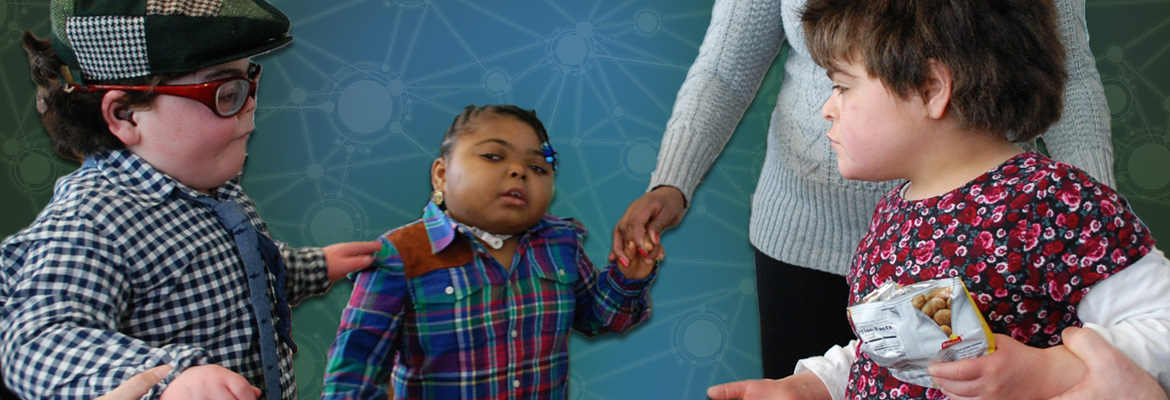Inspiration
Discovery Unites Three Families with Rare Syndrome

When they met as a group for the first time, Leta, Liam, and Nadira seemed to bond instantly. All three are under 4 feet tall, have similar mannerisms, wide-set eyes, and bubbly personalities. They live with chronic respiratory problems and other medical challenges, in addition to cognitive and physical developmental delays.
“They look more like siblings than their actual blood siblings,” said Melissa Ashton-Grant, mother of Nadira. “To see how they interacted with each other, it felt right.”
The children’s similarity was no coincidence — and confirming and understanding their connection was no small matter. The three families gathered in March to celebrate because researchers at The Children’s Hospital of Philadelphia had discovered the rare genetic mutation their children share, and had given their cryptic constellation of symptoms a name: CHOPS Syndrome. CHOPS is an acronym that stands for Cognitive impairment and coarse facial features, Heart defects, Obesity, Pulmonary involvement, Short stature and skeletal dysplasia (abnormal bone development).
A team led by Ian D. Krantz, MD, co-director of the Individualized Medical Genetics Center at CHOP and an associate professor at the Perelman School of Medicine at the University of Pennsylvania, with colleagues from the University of Tokyo, reported in Nature Genetics that a mutation in the gene AFF4 causes CHOPS Syndrome. The mutated AFF4 gene produces mutated proteins, which then accumulate and cause a cascade of abnormalities in other genes controlled by AFF4, leading to harmful effects in multiple organs and biological systems.
It is a finding the team could not have made without Nadira, age 11; Leta, 17; Liam, 15; and their families.
A Dangling Thread
For many years, Nadira Grant’s medical odyssey felt like a dangling thread. The little girl’s case was a question no doctor could answer. From her first respiratory crisis as a young infant, through her slowed physical and cognitive development, doctors could not identify the reason behind her symptoms. As far as they could tell, she was one of a kind.
“For so many years, I felt that I was alone going through this,” recalled her mother, Melissa, of Brooklyn. “I didn’t have anyone I could relate to.”
Along with her husband and a supportive extended family, Melissa persevered, raising her warm, loving daughter and seeing her through the unexplained medical and developmental challenges, never knowing what lay ahead. She also worried during subsequent pregnancies: Would Nadira’s two little sisters be at risk of developing the same mysterious disorder?
“Not knowing what the future has in store, the uncertainty made it much harder as a family,” she said.
Finding CHOPS
Melissa now has answers to some of these questions since Nadira’s diagnosis of CHOPS Syndrome.
Dr. Krantz had first suspected the three children were connected when his evaluation of all of them revealed their similar clinical features and characteristics. Kosuke Izumi, MD, PhD, then a resident in pediatrics and genetics in Dr. Krantz’ lab, spearheaded research to confirm that suspicion. The research team used relatively new technology to scan the children’s whole exome — the 20,000 expressed genes in the body — and identified their unique common difference in one of those genes – AFF4.
Dr. Krantz is excited by the discovery’s potential to help caregivers like Melissa better manage the disorder in their loved ones, and to better understand the underlying biology of a key developmental pathway.
“We can more effectively counsel families about recurrence risk for themselves and family members,” Dr. Krantz added.
They now know CHOPS Syndrome is a de novo condition — being caused by a new mutation arising in a single egg or sperm that went on to form the affected child, but not present in the patient’s parents. This reassured the CHOPS Syndrome families that any of their other children would not carry the change and that future children are extremely unlikely to be affected.
Threads Interwoven
Finally having an explanation and finding each other also means that the families’ medical odyssey is no longer a lonely one.
Leta’s mother, Lainey Moseley, of Philadelphia, said, “We share a medical bond and now have a support group to compare notes about our kids, like what medicines are the doctors prescribing for their lung disease? What kind of communication devices do we each use? Does your child have the same hyperactive personality as mine?”
In an interview with People magazine, Liam’s mother, Kathleen Hilferty, of West Chester, Pa., agreed: “I finally have someone to talk to who knows exactly what I’m dealing with.”
While the three families are finding strength in their newly interwoven lives, there is also the possibility that their community will grow. As has happened with a number of rare disorders that are being identified thanks to genetic sequencing, more families are beginning to come forward for evaluation and three more children have been identified from as far away as Australia and France. Perhaps other families’ struggles for a diagnosis will tie into the CHOPS tapestry soon.
“If they find an answer, they will share that sense of relief we’ve all felt,” Melissa said.

